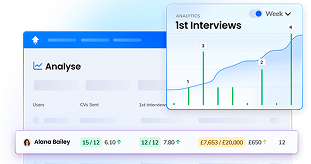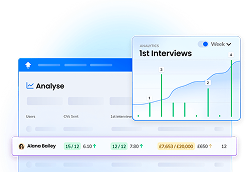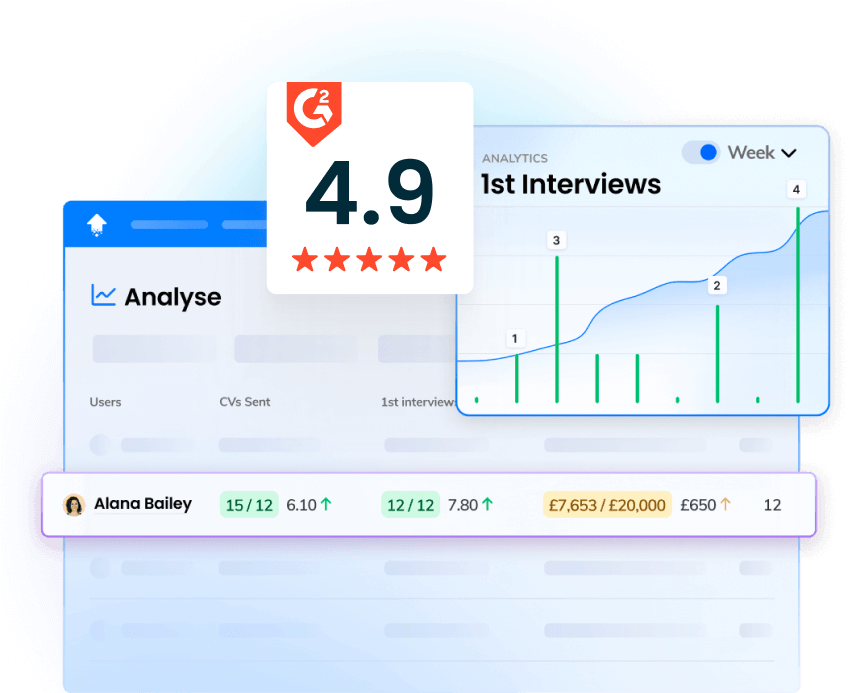Would your recruitment agency benefit from a steady pipeline of qualified candidates, a lower time-to-hire, and increased client satisfaction?
A strong talent pool management strategy is crucial to enable this.
In talent pool management, you build, nurture, and maintain a database of high-quality potential candidates for future hiring needs.
By maintaining relationships with potential hires, recruiters can quickly match top talent to new job openings — way before your competition does.
Here's everything you need to know about how to manage a talent pool in 2025.
What is Talent Pool Management?
Talent pool management is the strategic process of identifying, engaging, and nurturing a network of potential candidates for future hiring needs.
It involves maintaining relationships with skilled professionals — even when there are no immediate vacancies — in order to ensure a readily available pool of talent for when jobs do come in.
By fostering relationships with potential candidates through regular communication, organisations can secure top talent quickly when needed, maintaining a competitive advantage in the job market.
After all, if a recruiter has a talent pool ready when a client brings a job to the table, they will likely be able to fill the role much faster and with a higher-quality candidate, meaning the client receives a better service from the agency.
Indeed, effective talent pool management not only reduces time-to-hire, but improves recruitment efficiency, lowers costs, and enhances workforce planning.
So, what's the difference between a talent pool and a talent pipeline?
Talent pools consist of a diverse group of pre-qualified candidates who may be considered for various roles over time.
In contrast, talent pipelines are more structured and role-specific, focusing on candidates actively progressing toward a particular position.
This means that while talent pools serve as a broad database of potential hires, talent pipelines involve more targeted recruiting engagement and development for specific job openings.
Why Keeping Your Talent Pool Warm is Crucial in 2025
In 2025, we're operating in a fiercely competitive recruitment landscape, thanks to skills shortages, rapidly developing tech, evolving job market trends and shifting candidate expectations.
To survive and thrive in this challenging recruitment arena, employers must take a proactive approach to hiring.
This means cultivating quality talent pools and then putting in the work to keep them warm — or, in other words, engaged, informed, and interested in potential opportunities.
To keep your talent pool warm, regular engagement is crucial.
Use a smart combination of the following impactful tactics to nurture relationships with potential candidates:
➡️ Leverage social media
➡️ Host webinars
➡️Maintain an active employer brand
➡️ Send personalised emails
➡️ Share industry insights
➡️ Share job updates
➡️ Post networking opportunities
Of course, you don't want to overwhelm candidates with your communication — but you also don't want to let your talent pool go cold.
Not only does this mean you've wasted a lot of time building and managing a talent pool, but it also leads to higher recruitment costs and longer hiring processes.
A disengaged talent pool means starting from scratch when a vacancy arises, resulting in delayed hires and missed business opportunities.
In contrast, a warm talent pool ensures a steady flow of pre-qualified candidates, significantly reducing time-to-hire.
With engaged candidates ready to step in, businesses can fill critical roles faster, improving efficiency and maintaining a competitive edge.
Steps to Effective Talent Pool Management
Cultivating a high-quality talent pool greatly benefits your recruitment agency — that much is clear.
But, if you're used to taking a different approach to recruiting, it can be hard to know where to start when it comes to proactive recruitment.
With this in mind, here are six steps to building a talent pool packed with engaged, responsive, high-quality candidates.
1. Segmenting Your Talent Pool
Personalised communication is no longer merely a 'nice to have' in 2025.
Indeed, your candidates will be used to personalisation in every aspect of their life, from their playlists and streaming services to supermarket loyalty programmes and news services.
It's vital to keep up.
If a recruiter fails to achieve personalisation, it can feel jarring and dent a potential candidate's trust in the brand.
This is where segmentation comes in — segmenting a talent pool is essential for targeted and efficient recruitment.
To do this, categorise candidates by:
- Industry
- Skill set
- Engagement level
This allows you to quickly identify suitable candidates for specific roles and empowers you to tailor your communication strategies without this task becoming a huge time sink.
For example, suppose your agency specialises in a few different niches.
You wouldn't want to send an email newsletter round-up of medical jobs to candidates in the engineering field.
Not only would these roles be irrelevant to that audience, but sending this email could also make your agency look unprofessional, make job seekers feel undervalued, and cause them to actively disengage from your agency.
You can also tailor communication strategies based on candidate engagement.
Active candidates who are job-seeking benefit from direct job offers and interview invitations.
Passive candidates who aren't actively looking require a softer approach, such as industry insights, networking opportunities, and company updates.
By segmenting your talent pool, you enhance candidate engagement, streamline hiring, and improve response rates, ensuring a more effective and personalised recruitment process.
2. Leveraging Recruitment Technology and Automation
With cutting-edge recruitment technology on the market, keeping your recruitment pipeline warm has never been easier.
In 2025, you can invest in automation tools that streamline talent pool management, boosting efficiency and engagement.
For example, modern ATS and CRM software helps track, organise, and nurture candidates, ensuring no potential hire is overlooked.
Meanwhile, recruitment analytics tools like OneUp empower you to refine your strategy by delivering a clear, real-time talent pool analysis that explains which tactics are working and which are not.
Automated email campaigns, chatbots, and scheduling tools further optimise candidate interaction.
By integrating these technologies, recruiters save time, reduce hiring costs, and maintain a warm, well-structured talent pool.
This proactive approach ensures faster, data-driven hiring decisions and a stronger pipeline of qualified candidates.
3. Regular Engagement Strategies to Keep Candidates Warm
In order to deliver the results you want, your talent pool needs constant attention.
It's no surprise that regular engagement strategies are essential for keeping candidates interested and connected to your organisation.
Get this right, and you should cut time-to-hire and boost overall recruitment success.
Furthermore, keeping candidates engaged enhances their experience, ensuring they are more receptive when the right opportunity arises.
Here are some key engagement strategies to try out:
➡️ Send personalised content, such as industry trends, company news, and job alerts, via email and direct messages to keep talent pool members informed and engaged.
➡️ Host virtual events, webinars, and networking sessions to foster relationships and keep your employer brand top of mind. Remember — interactive events allow candidates to engage with recruiters and company leaders, building trust and loyalty.
➡️ Deploy a social media/community engagement strategy where you actively share insights, company culture, and employee success stories through LinkedIn, Twitter, or talent communities. This strengthens brand perception and maintains candidate interest.
4. Data-Driven Talent Pool Optimisation
Data-driven talent pool optimisation ensures your recruitment strategy remains efficient and effective.
By leveraging recruiting analytics software like OneUp, recruiters can make informed decisions, improving hiring outcomes.
And this isn't as complicated as it sounds.
Start by measuring engagement levels using talent pool analytics.
Engagement metrics you might want to track include:
- Email open rates
- Event participation
- Response rates
Not only will tracking these metrics show you which tactics are working and which aren't, but they also help you to identify active and passive candidates, which helps tailor communication strategies accordingly.
Predictive analytics tools, meanwhile, aim to identify top candidates based on skills, experience, and past interactions, further optimising your strategy.
These AI-driven insights help prioritise individuals most likely to be a good fit for upcoming roles, reducing time-to-hire.
Remember — it's vital to regularly clean and update your database to ensure accuracy, prevent wasted effort, and keep the talent pool relevant.
By continuously refining and optimising the talent pool with data insights, recruiters can improve candidate engagement, streamline hiring processes, and ensure they have access to the best talent when needed.
5. The Role of Employer Branding in Talent Pool Management
Employer branding plays a pivotal role in candidate pool management.
How?
It can significantly influence candidate engagement.
A strong, authentic employer brand attracts top talent, builds trust, and encourages candidates to stay connected.
When candidates perceive a company positively, they are more likely to engage and consider future opportunities.
To showcase your employer value, focus on highlighting company culture, employee success stories, and benefits through various channels, such as social media, company websites, and employee testimonials.
Ensure your messaging is transparent, consistent, and authentic to create a compelling brand that resonates with candidates, ensuring a warm and engaged talent pool.
6. Avoiding Common Talent Pool Management Pitfalls
While, thanks to cutting-edge tech, keeping your talent pool warm is easier than it used to be, there are still several pitfalls to watch out for.
Here are three major challenges to prepare for in talent pool management:
1. Overloading Candidates with Irrelevant Communication
Overwhelming candidates with communication that is not relevant to them can easily lead to disengagement and can even damage your agency's professional reputation!
Excessive, off-topic messages can frustrate candidates, making them less likely to respond or consider future opportunities.
It can also make the agency look amateur, spammy, or like they don't understand their audience.
Instead, send personalised, relevant content tailored to the candidate's skills, interests, and career goals.
This way, you maintain positive engagement and foster good relationships with potential hires.
2. Failing to Personalise Engagement Efforts
Similar to overloading candidates with irrelevant information, failing to personalise engagement efforts can make candidates feel undervalued and overlooked.
What happens then?
Rapid disengagement.
Personalisation shows candidates that you understand and care about their skills, interests, and career goals — in other words, you value them.
By tailoring communication to individual candidates, recruiters create a more meaningful experience, increasing the likelihood of continued interest and enhancing the employer brand, ultimately leading to a more effective talent pool management strategy.
3. Not Utilising Technology for Tracking and Insights
Using advanced tech tools for data tracking and insights is essential in talent pool management.
It enables recruiters to efficiently monitor candidate engagement, preferences, and progress.
Furthermore, it also empowers you to continuously refine your strategy in line with your insights, driving performance and efficiency.
For instance, tools like ATS and CRM systems provide valuable data, helping recruiters make informed decisions, optimise communication, and identify top talent.
Recruitment software can also streamline processes, cut administrative workload, and ensure no potential candidate is overlooked, leading to a more effective and responsive recruitment strategy.
How OneUp Can Help
If you're aiming for talent pool management success, a sophisticated recruitment analytics platform is a must.
OneUp integrates with a wide range of recruitment software, including CRMs, ATS', Timesheets, and VoIP.
Simply set up custom dashboards and reports to track your talent pool metrics, and OneUp automatically pulls real-time data from across your tech stack to give you an up-to-the-minute performance overview whenever you need one.
It's easy to see which tactics are working and which are not and which candidates are more likely to make the cut and which are not.
These real-time insights empower recruiters to confidently make data-driven decisions around their talent pool.
OneUp also specialises in tracking recruitment performance metrics, allowing recruitment team leaders and recruiters to track their progress against their SMART goals.
The platform's gamification tools — including live leaderboards and celebration anthems — are excellent when it comes to motivating recruiters to hit their goals and bag that incentive.
Conclusion
Remember! To keep your talent pool nice and warm:
✅ Segment your talent pool
✅ Leverage recruitment technology and automation
✅ Deploy regular engagement strategies
✅ Conduct data-driven talent pool optimisation
✅ Develop strong, authentic agency branding
✅ Avoid common pitfalls, including overloading candidates with irrelevant information, failing to personalise engagement efforts, and not utilising tech for tracking and insights.
➡️ Ready to cultivate a warm, engaged and responsive talent pool? Book a OneUp demo today to find out how our recruitment analytics tools could help you optimise talent engagement.




















